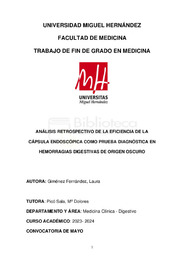Título :
Análisis retrospectivo de la eficacia de la cápsula endoscópica como prueba diagnóstica en hemorragias digestivas de origen oscuro |
Autor :
Giménez Fernández, Laura |
Tutor:
Picó Sala, María Dolores |
Editor :
Universidad Miguel Hernández |
Departamento:
Departamentos de la UMH::Medicina Clínica |
Fecha de publicación:
2024-05-03 |
URI :
https://hdl.handle.net/11000/33746 |
Resumen :
INTRODUCCIÓN
La cápsula endoscópica (CE) ha surgido como una herramienta segura para la evaluación de las hemorragias digestivas de origen oculto (HDOO), permitiendo la visualización completa del intestino delgado. El objetivo primario del estudio es analizar su eficiencia diagnóstica.
MATERIAL Y MÉTODOS
Se ha realizado un estudio observacional, analítico y retrospectivo en el Hospital General Universitario de Elche (HGUE) con el fin de evaluar la eficiencia de la CE tras un episodio de HDOO. Se han incluido 28 pacientes, recogiendo sus datos clínicos a través de diferentes bases de datos.
RESULTADOS
La CE fue diagnóstica en el 44,4% de los casos, de los cuales se hallaron angiodisplasias en el 66,6%. El consumo de AINEs y el tratamiento anticoagulante y/ o antiagregante incrementan el porcentaje de detección de lesiones y el patrón clínico en forma de melenas asocia el mayor porcentaje diagnóstico. Además, a pesar de que el 72% se encontraba hospitalizado durante su realización, no se hallan variaciones significativas respecto a las CE que se llevaron a cabo de forma ambulatoria.
CONCLUSIONES
La CE es esencial en la evaluación de las HDOO, sin embargo, todavía existe un porcentaje elevado de episodios sin diagnóstico. Las agiodisplasias constituyen el hallazgo más frecuente, predominando su aparición tras el conusmo de AINEs, anticoagulantes y/ o antiagregantes.
INTRODUCTION
Small- bowel capsule endoscopy (SBCE) has emerged as a safe procedure for the evaluation of obscure gastrointestinal bleeding (OGIB), allowing complete visualization of the small bowel. The primary objective of the study is to analyze its diagnostic efficiency.
MATERIAL AND METHODS
An observational, analytical and retrospective study has been carried out at the General University Hospital of Elche (HGUE) in order to evaluate the efficiency of SBCE after an episode of OGIB. Twenty-eight patients were included, collecting their clinical data through different databases.
RESULTS
SBCE was diagnostic in 44.4% of cases, of which angiodysplasias were found in 66.6%. The use of NSAIDs, anticoagulant or antiplatelet therapy increased the percentage of lesion detection, and the clinical pattern in the form of melena was associated with the highest diagnostic percentage. Also, despite the fact that 72% were hospitalized during the study, no significant variations were found with respect to the SBECs that were performed on an outpatient basis.
CONCLUSIONS
SBEC is essential in the evaluation of OGIB cases, however, there is still a high percentage of undiagnosed episodes. Agiodysplasias are the most frequent finding, predominantly after the use of NSAIDs, anticoagulants or antiplatelet agents.
|
Palabras clave/Materias:
cápsula endoscópica
hemorragia digestiva de origen oculto
angiodisplasia
AINEs
anticoagulante
antiagregante |
Área de conocimiento :
CDU: Ciencias aplicadas: Medicina |
Tipo de documento :
info:eu-repo/semantics/bachelorThesis |
Derechos de acceso:
info:eu-repo/semantics/openAccess
Attribution-NonCommercial-NoDerivatives 4.0 Internacional |
Aparece en las colecciones:
TFG- Medicina
|
 La licencia se describe como: Atribución-NonComercial-NoDerivada 4.0 Internacional.
La licencia se describe como: Atribución-NonComercial-NoDerivada 4.0 Internacional.
.png)
